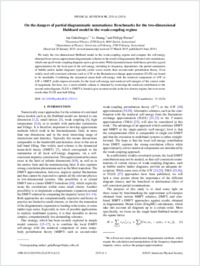On the dangers of partial diagrammatic summations: Benchmarks for the two-dimensional Hubbard model in the weak-coupling regime
- Gukelberger, Jan Theoretical Physics, ETH Zurich, Switzerland
- Huang, Li Department of Physics, University of Fribourg, Switzerland
- Werner, Philipp Department of Physics, University of Fribourg, Switzerland
-
09.06.2015
Published in:
- Physical Review B. - 2015, vol. 91, no. 23, p. 235114
English
We study the two-dimensional Hubbard model in the weak-coupling regime and compare the self-energy obtained from various approximate diagrammatic schemes to the result of diagrammatic Monte Carlo simulations, which sum up all weak-coupling diagrams up to a given order. While dynamical mean-field theory provides a good approximation for the local part of the self-energy, including its frequency dependence, the partial summation of bubble and/or ladder diagrams typically yields worse results than second-order perturbation theory. Even widely used self-consistent schemes such as GW or the fluctuation-exchange approximation (FLEX) are found to be unreliable. Combining the dynamical mean-field self-energy with the nonlocal component of GW in GW + DMFT yields improved results for the local self-energy and nonlocal self-energies of the correct order of magnitude, but here, too, a more reliable scheme is obtained by restricting the nonlocal contribution to the second-order diagram. FLEX + DMFT is found to give accurate results in the low-density regime, but even worse results than FLEX near half-filling.
- Faculty
- Faculté des sciences et de médecine
- Department
- Département de Physique
- Language
-
- English
- Classification
- Physics
- License
- License undefined
- Identifiers
-
- RERO DOC 257366
- DOI 10.1103/PhysRevB.91.235114
- Persistent URL
- https://folia.unifr.ch/unifr/documents/304534
Statistics
Document views: 65
File downloads:
- wer_odp.pdf: 175
